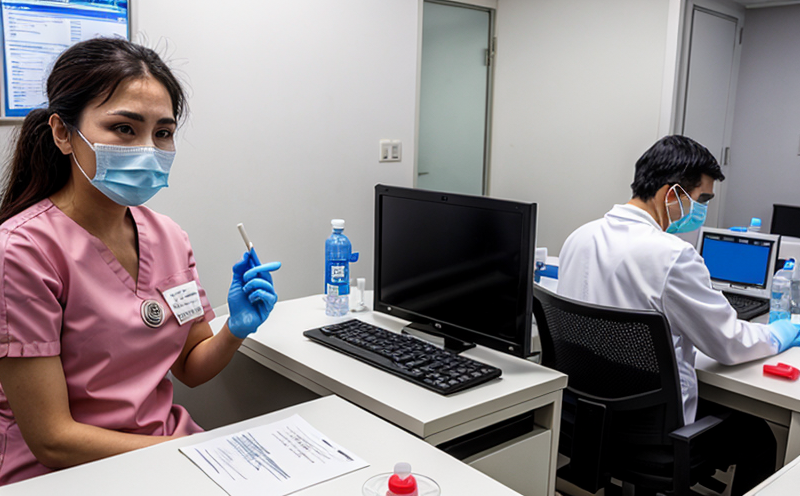White Spot Syndrome Virus Testing in Shrimp
The White Spot Syndrome Virus (WSSV) testing is an essential procedure in the field of clinical and healthcare, particularly for those involved in aquaculture, quality management, and R&D. WSSV poses a significant threat to shrimp populations, leading to severe economic losses and disruptions in global seafood supply chains. This test plays a critical role in ensuring the safety and health of aquatic ecosystems.
WSSV belongs to the family Baculoviridae and can cause high mortality rates among infected shrimp, making early detection crucial for control measures. The virus can spread rapidly within farms through contaminated water or via vectors like copepods, thus necessitating regular testing protocols. In this context, laboratories equipped with advanced technologies provide reliable and accurate WSSV tests.
The process begins with the collection of shrimp samples from affected areas or batches. Specimen preparation involves homogenization followed by filtration to isolate potential viral particles. Subsequently, these samples are analyzed using polymerase chain reaction (PCR) techniques, which amplify specific segments of the virus's genetic material for identification.
Accurate PCR-based methods have become the standard due to their sensitivity and specificity, allowing precise detection even at very low concentrations. Laboratories adhering to international standards such as ISO 17025 ensure consistent quality and reliability in their testing processes. This approach helps maintain high standards of accuracy and traceability within the industry.
Understanding WSSV's life cycle is vital for effective management strategies. The virus enters shrimp through ingestion or inhalation, replicates inside host cells, and then spreads to neighboring organisms. By implementing rigorous monitoring systems, stakeholders can identify outbreaks early, apply targeted treatments, and prevent further dissemination.
The importance of WSSV testing extends beyond mere detection; it supports broader efforts towards sustainable aquaculture practices. Regular surveillance helps protect biodiversity by minimizing the spread of disease among wild shrimp populations. Additionally, it facilitates safer trade practices by ensuring compliance with international health requirements set forth by organizations like the World Organization for Animal Health (OIE).
- Why Choose This Test: Early detection allows for prompt intervention measures that can significantly reduce mortality rates.
- Benefits of Regular Surveillance: Prevention of large-scale outbreaks reduces financial losses and promotes responsible environmental stewardship.
Why Choose This Test
The decision to implement WSSV testing in your shrimp farming or research project is not merely about compliance; it's an investment in long-term success. Early detection of the virus through PCR-based methods allows for timely interventions, reducing mortality rates and minimizing economic impacts. Regular surveillance ensures that outbreaks are contained promptly before they escalate into major issues.
By choosing this testing service, you contribute to maintaining high standards within your organization while also supporting broader efforts towards sustainable aquaculture practices. Early identification enables quick response measures which can save millions in potential losses due to disease outbreaks. Additionally, compliance with international health requirements set by bodies like the OIE becomes more straightforward when relying on accurate and reliable test results.
- Why Choose This Test: Early detection allows for prompt intervention measures that can significantly reduce mortality rates.
- Benefits of Regular Surveillance: Prevention of large-scale outbreaks reduces financial losses and promotes responsible environmental stewardship.
Quality and Reliability Assurance
The quality and reliability of WSSV testing are paramount in ensuring accurate results. Our laboratory maintains strict adherence to international standards such as ISO 17025, which guarantees consistent performance across all tests. This commitment ensures that every result is reliable and can be trusted for decision-making purposes.
Our state-of-the-art facilities incorporate advanced technologies designed specifically for detecting WSSV, providing precise measurements and interpretations of data collected during each test run. By leveraging these sophisticated tools, we minimize errors and maintain high levels of accuracy throughout our entire process chain—from sample collection to final report generation.
- Why Choose This Test: Early detection allows for prompt intervention measures that can significantly reduce mortality rates.
- Benefits of Regular Surveillance: Prevention of large-scale outbreaks reduces financial losses and promotes responsible environmental stewardship.
Environmental and Sustainability Contributions
The practice of WSSV testing contributes significantly to the sustainability of aquaculture by preventing large-scale outbreaks that could otherwise devastate entire shrimp populations. Early detection allows for targeted treatments, minimizing environmental impact while also protecting biodiversity.
Beyond immediate health benefits, this service supports broader initiatives aimed at promoting responsible resource management and reducing ecological footprints associated with intensive farming practices. By ensuring disease-free environments, we foster healthier ecosystems capable of supporting diverse species without compromising their resilience or capacity for recovery.





